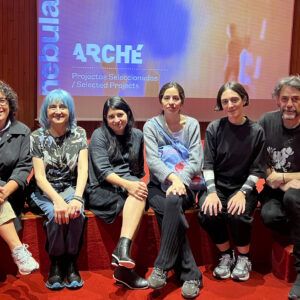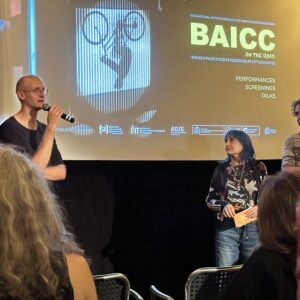
Stefano Canapa discusses with us his exploration of sound in his work: we talk about his performance Wavelength –along with the sound artist Antoine Birot– and his film The Sound Drifts, included in our program Old Friends, New Friends (Viejos y nuevos amigos).
WAVELENGTH
Antoine Birot: for creating my work I use two generators of low frequencies, which are devices you can find at electronic labs, and which are used to measure electricity currents. They generate an electric signal –therefore, a sound. I register that electric signal, and with it I build the sound work live, according to the improvisation that is taking place. Also, the specific devices I use are quite old, and that allows me to play with the unexpected noises they make, the sounds resulting of their, let’s say, malfunctioning.
Stefano Canapa: Yes. Also, one of the original uses of those machines was to fix TV sets, so when we started working together one of our first ideas was that we could take this frequency back to the TV set. And we discovered –because this was an exploration– that this generated a kind of video feedback, which produced, in its turn, a very interesting abstract image. We also realised that if you alter the frequency, those changes are replicated in the image. So we filmed again the images in the TV, this time in 16mm, improvising with the instrument to generate sound –which derived in a simultaneous improvisation with the images. Then came a process that took place in the laboratory, involving photochemical processes, developing the film… I used different machines that allowed me to explore different possible results. The final step was using the visual material that we had generated using this method and accompanying it with live sound, so that image and sound are reunited.
THE SOUND DRIFTS
S. C.: The Sound Drifts is the result of a lab-centred process. I was copying the previous film I had made with Jérôme Noetinger. The film is a documentary approach to his work. I asked him to do an improvised performance for the camera (I used two cameras), and I gave him an indication: that the performance had to last for the duration of a 16 mm can, which we then blew up to 35mm. The only thing I’m not able to do at our lab is the Dolby Surround sound, because it’s too complex, so I commissioned it from a commercial laboratory. And what happened is that they there was a digital failure. I sent the sound file in a USB device, but when I saved it in the device, the process failed. So the resulting file was corrupt. However, Jérôme’s music is very experimental, so… the person in charge of manipulating the file didn’t realise there was a problem. It’s not possible to listen to the optic negative –you need to print it before, and then you can listen to it. So I made the copy, and when I projected it, I realised that there was a blank space in the soundtrack, around minute 8:20. My film was about Jérôme’s work as a sound artist, so this really annoyed me. I asked the lab to repeat the process, but I kept that first negative. And in order to identify what the problem was, you need to project it. You need to disassemble some parts of the projector to see what is not usually projected, that is: the optic sound. From there, I started reflecting on the possibility on bringing to the screen that part of the film that’s never shown.
Usually, when you project an image, the sound that goes with it is projected about 20 images later, because, in cinema, the image (that has a bulb of several kW on it) cannot be read at the same time that sound is read, because sound is a very thin mark. Back then, the way they found for solving this, was to move sound forward: the reading is performed in two different places. In this case, since I was the one making the copy, I could print the image and the sound according to this gap. That’s why, in the final result, what you see is what you get: you see the same thing you’re hearing.





